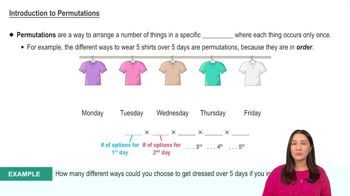Here are the essential concepts you must grasp in order to answer the question correctly.
Permutations
Permutations refer to the different ways in which a set of items can be arranged or ordered. In mathematics, the number of permutations of 'n' items taken 'r' at a time is calculated using the formula P(n, r) = n! / (n - r)!, where 'n!' denotes the factorial of 'n'. This concept is crucial for understanding how to count arrangements when the order of selection matters.
Recommended video:
Introduction to Permutations
Factorial
A factorial, denoted as 'n!', is the product of all positive integers up to 'n'. For example, 5! = 5 × 4 × 3 × 2 × 1 = 120. Factorials are fundamental in combinatorics, particularly in calculating permutations and combinations, as they provide a way to quantify the total arrangements of a set of items.
Recommended video:
Combination vs. Permutation
The distinction between combinations and permutations is essential in combinatorial mathematics. While permutations consider the order of selection (e.g., ABC is different from ACB), combinations focus solely on the selection itself, disregarding order (e.g., ABC is the same as ACB). Understanding this difference is vital when determining which formula to apply in problems involving arrangements.
Recommended video:
Permutations vs. Combinations
 Verified step by step guidance
Verified step by step guidance Verified video answer for a similar problem:
Verified video answer for a similar problem:



 4:4m
4:4m